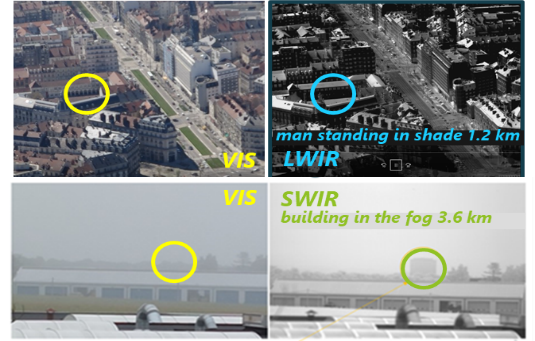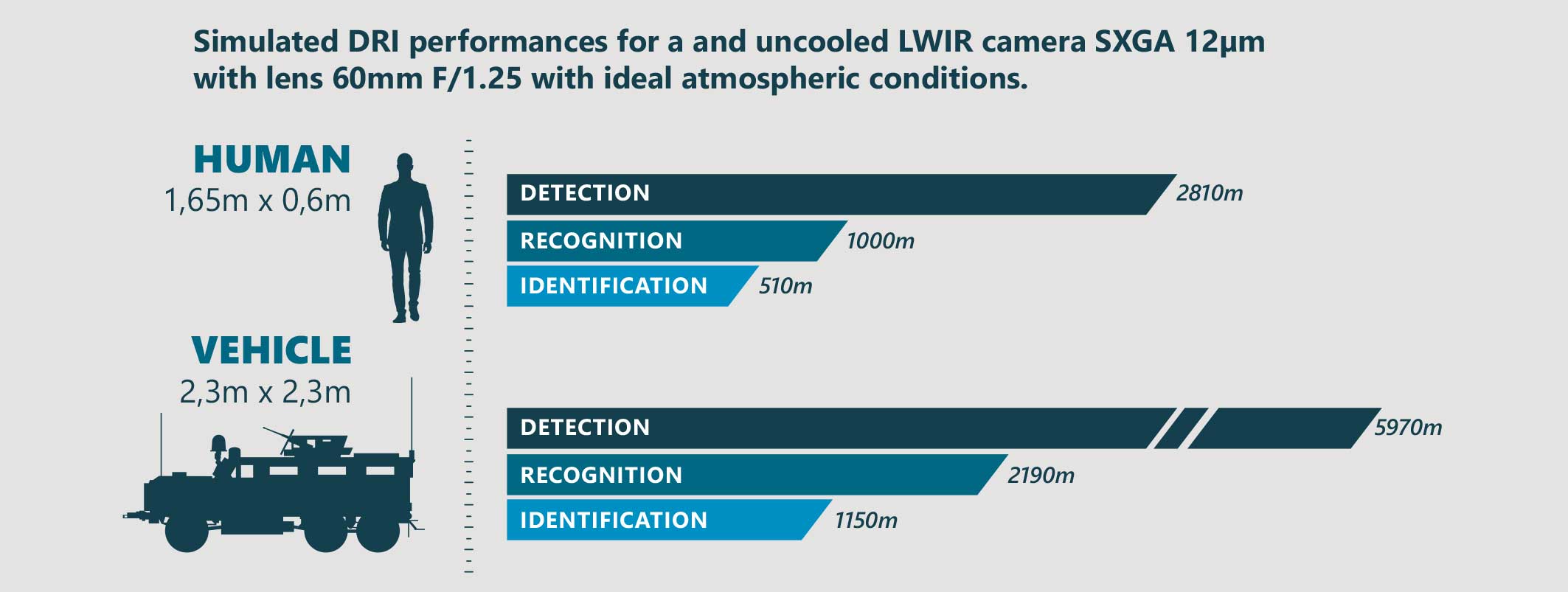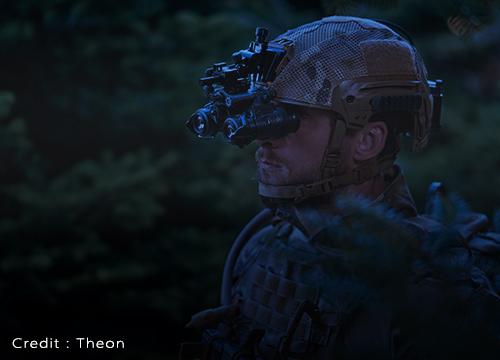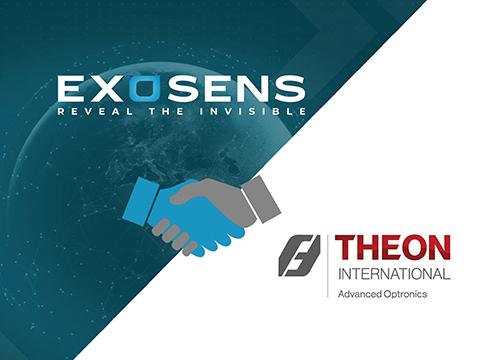Imaging Conditions: Seeing Through Any Challenge
Micro UAVs frequently integrate visible-spectrum and LWIR thermal cameras, enabling versatile performance in both day and night conditions. But why is this dual capability crucial? Regardless of the mission—whether guiding, detecting, or monitoring—the ability to see clearly is often dictated by environmental challenges.
Day Vision
While daylight visibility might seem straightforward, variations in lighting—like shadows or glaring sunlight—pose significant challenges. High-dynamic-range sensors in the visible spectrum effectively address these issues, delivering consistent performance across varying light conditions.
Night Vision
At night, illuminating a scene is impractical for long distances or in situations where stealth is critical, such as in security or reconnaissance missions. This is where advanced photonic technologies excel, including:
• Light intensification technology to amplify minimal light,
• Low-light visible cameras for enhanced clarity, and
• Infrared cameras, especially thermal MWIR and LWIR models, designed to perform exceptionally in low-light environments.

Degraded Environmental Conditions
In harsh conditions like haze, fog, or smoke, visible-spectrum cameras struggle due to photon scattering. SWIR cameras provide a significant edge in such scenarios, as their ability to penetrate these obstacles ensures better visibility.
Active Imaging and High-Light Environments
For specific missions, active imaging technologies such as time-controlled laser sources (e.g., LIDAR) can deliver precise results. However, these solutions are unsuitable for stealth operations. Alternatively, imaging in extremely bright environments has been enhanced with innovations like anti-blooming sensors or even solar blind capable sensors.
Mission-Driven Technology Choices
The mission profile of the UAV ultimately dictates the choice of imaging payload. Each camera technology brings distinct advantages tailored to specific operational requirements, ensuring mission success in even the most challenging conditions.
Decoding Performance: The Power of DRI in UAV Operations
Learn how Johnson's criteria enhance mission effectiveness across military and civilian. The military community frequently relies on the DRI range, also known as Johnson’s criteria (for infrared night imaging). This framework defines the distances at which a system can:
- Detect (“I see something”);
- Recognize (“I can determine if it is a person or a vehicle”);
- Identify (“I can qualify its features and assess whether it is a threat”).
While originally designed for military use, DRI range is equally beneficial for various platforms and UAVs. It enhances operational efficiency across diverse scenarios:
- Search-and-Rescue: Detecting a victim at a distance.
- Infrastructure Monitoring: Recognizing a defect in critical assets.
- Flight Safety: Detecting obstacles such as cables early enough to avoid them.

DRI values are initially calculated but should ideally be validated in real-world conditions. For a specific setup and under consistent atmospheric conditions, the DRI thresholds will vary based on the target size—whether it’s a person, a light vehicle, or a truck. The evaluation involves determining the number of adjacent pixels on the image for an object observed at a distance. These thresholds are directly tied to the resolution and sensitivity of the camera—and by extension, the entire electro-optic system. Both parameters are driven by the quality of the optics and the detector.
UAV Specifications: The Role of Lenses and Camera Cores
UAV applications often demand long-range vision capabilities, making zoom lenses a common choice, particularly in the visible spectrum. However, in the infrared spectrum (e.g., LWIR), zoom lenses are less frequently adopted despite their inherent advantages.
The difference lies in the detectors: LWIR detectors typically have a larger pixel pitch (ranging from 17 µm to 8 µm) compared to visible detectors (which range from 8 µm to as small as 1 µm). To achieve equivalent resolution, LWIR arrays require a larger sensitive area, resulting in larger and heavier lenses. Additionally, lower production volumes for LWIR lenses lead to significantly higher costs compared to their visible-spectrum counterparts.
Lens Options for UAV Payloads
- Zoom Lenses: LWIR zoom lenses are commonly used in small UAVs, standard UAVs, and MALE (Medium Altitude Long Endurance) payloads. However, their weight, size, and power consumption make them less practical for smaller UAVs.
- Dual Focal Length Lenses: These lenses can be a viable alternative to zoom lenses. While they offer flexibility, their footprint and power requirements are often comparable to those of zoom lenses.
- Fixed Focal Length Lenses: For nano and micro UAVs, fixed focal length lenses are the preferred option due to their lower weight, size, and power consumption.
Optimizing System Design for DRI Performance
To achieve the desired Detection, Recognition, and Identification (DRI) performance, system designers can consider two primary configurations:
- Mid-Resolution Camera Core + Zoom Lens: A mid-resolution core (e.g., VGA) paired with a powerful zoom lens offers flexibility in adapting to different scenarios.
- High-Resolution Core + Smaller Lens: A high-resolution core (e.g., SXGA) allows the use of smaller lenses, which can reduce overall system weight and size.
Alternatively, some systems may employ two fixed focal length LWIR channels: one with a wide field of view (FOV) for low DRI and another with a narrow FOV for high DRI.
SWaP Optimization: Essential for Smaller UAVs
The smaller the UAV, the more critical SWaP optimization becomes. Size, Weight, and Power—commonly referred to as SWaP—directly influence a UAV’s platform category, onboard power capacity, take-off weight (TOW), endurance, and operational autonomy. As UAVs decrease in size, the importance of SWaP-efficient components grows exponentially.
While large UAVs and MALE (Medium Altitude Long Endurance) drones can accommodate heavy payloads such as multiple cameras (often with cooling systems), optical zoom lenses, and protective windows, SWaP becomes progressively indispensable for smaller platforms. For small and mini UAVs, SWaP optimization is advantageous, but for nano and micro UAVs, it is non-negotiable.
Beyond optics, system designers face numerous challenges, including:
- Data flow management: High-resolution sensors and/or higher frame rates demand greater processing power.
- Processing location: Deciding whether to process data within the camera core, onboard the drone, or at a ground console.
- Synchronization and calibration: Ensuring system components align seamlessly.
Every detail matters in achieving optimal performance.
For LWIR cameras, shutterless designs present an appealing solution, eliminating the drawbacks of mechanical shutters. These cameras offer lightweight, low-maintenance alternatives without compromising performance. Notably, Exosens provides both shuttered and shutterless LWIR camera variants, offering tailored solutions to meet diverse operational needs.
By embracing SWaP optimization, UAV designers can unlock new possibilities in smaller, more agile drone platforms.
Exosens Offering – Find Exactly What You Need
Exosens has a proven track record in supporting aerial platforms, both manned and unmanned. Our expertise extends across a wide range of UAVs, from small UAVs and their payloads to micro-UAVs and nano-UAVs.
- LWIR Cameras: Explore our extensive selection of long-wave infrared (LWIR) cameras, offering a variety of wavelengths, resolutions, video interfaces, lenses, and mechanical configurations to meet diverse needs.
- SWIR, Low-Light Visible, and UV Cameras: Complementing our LWIR solutions, we provide cutting-edge cameras optimized for short-wave infrared (SWIR), low-light visible, and ultraviolet imaging.
Looking for something beyond standard offerings? We are ready to collaborate and discuss customized, tailor-made solutions to perfectly fit your unique requirements.




